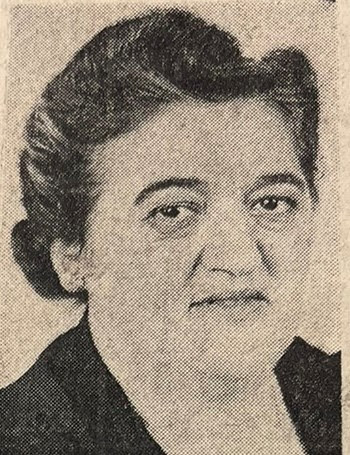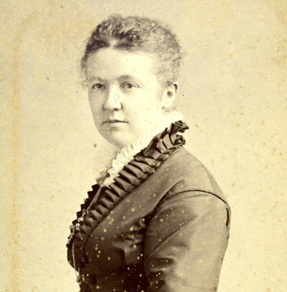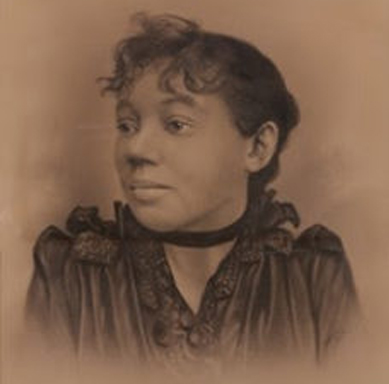A resourceful real estate investor and astute textile mill treasurer, Ada Woolley Sullivan (1888-1968) became New Bedford’s first woman textile mill treasurer and took full charge of the Sullivan Silk Mills in 1934. As a realtor, Ada “flipped” many houses in the North and South Ends of New Bedford long before the term came into being.
A resourceful real estate investor and astute textile mill treasurer, Ada Woolley Sullivan (1888-1968) became New Bedford’s first woman textile mill treasurer and took full charge of the Sullivan Silk Mills in 1934.
Ada Woolley was born in Ashton-under-Lyne, Lancashire, England, in 1888, the youngest of Isabella (Fish) and John Woolley’s eight children. In 1891, John decided that he and his family would leave England’s difficult working conditions and take the perilous journey across the Atlantic to find a better life in America. The family disembarked in Boston and settled in the textile city of New Bedford, Massachusetts, close to the sites of numerous thriving mills. The work experience and knowledge that they brought with them were welcome in the mills of New Bedford.
The Woolley children were compliant and accepted the decision of their father when school days were over and it was time to go to work in the mills. On pay day, the youngsters would arrive at home after work, and, one by one, pass their wages to their father, who would deduct a small amount for them and pocket the rest. In this way, parents were able to support their households and put away money for their future needs. This process would continue every week until the children married, at which time their paychecks would remain in their own pockets.
At an early age, Ada had informed her parents that she would remain in school until she had learned what she needed to know. She made it clear that when she went into the working world, it would NEVER be in a mill! Ada loved school and absorbed all that her classes had to offer. Throughout the years, she incessantly requested extra work from her teachers, especially in mathematics, that took her beyond her grade level and then beyond the next, as she strived to take in as much information as quickly as she could. Too soon, however, her father proclaimed that she had been allowed extra time to complete her freshman year of high school and was way overdue to go to work. Ada was sad, but not without a plan. She had become so advanced in her mathematical skills that she was able to convince the local grocer and family friend to try her out as his bookkeeper. He knew of the extraordinary Ada Woolley, the neighborhood beauty, who was incredibly intelligent. He was very curious about her ability, and since he had recently found himself without a bookkeeper, he put a desk for her at the back of his shop and gave her two weeks to prove that she could handle the job. She worked there for 10 years.
Joseph A. Sullivan was older than Ada, a sophisticated, charming 38-year-old Irishman, whose friendliness, stimulating conversation, and intelligent assessment of everything from world events to baseball statistics, drew people to him. He was exceptionally well informed on all matters of interest, especially politics, and the “11:30 Club” on Acushnet Avenue, his thriving North End pub, was usually packed with patrons who enjoyed the lilt of the Irish brogue in his speech, together with his wonderful sense of humor. Joe had, before reaching the age of 30, lifted himself from near poverty to prominence in his community, and only his most observant customers noticed that he had acquired his own liquor label. He maintained stocks of alcohol shipped from Kentucky that were stored in secure locations until Joe called for them. The only other person to whom all this was known was an elderly business associate Joe trusted. This man even knew that a lovely young woman named Ada had stolen Joe’s heart.
Ada’s parents had brought with them from England many old customs and prejudices, particularly their hatred of all things Irish. Joe Sullivan, while born and raised in the United States by his Irish parents, was well aware of their loathing of the English, who had wreaked such horror and misery on their former homeland and forced hundreds of thousands of people, like themselves, to flee their beautiful country in order to survive.
Ada and Joe’s attraction had been instant and electric. From the beginning, however, they had been struggling with conflicts in their relationship. She was a steadfast Methodist; he was a devout Catholic. She favored the Republican Party (though women had not yet been granted the right to vote), while he was an active member of the Democratic Party. Those were but minor problems compared to the wall of resistance they knew would hit when their parents, particularly their mothers, Isabella Fish Woolley and Mary O’Connor Sullivan, discovered that their children had fallen in love with the enemy. They had almost reached an impasse in their relationship, when, suddenly, Ada told him that she was going to have a baby. Joe was stunned, but realized that they would have to put all of their differences aside and provide a united family for their child. In true Ada style, she invited her mother to have tea with her one afternoon, and announced with great pride and confidence that she was going to marry Joe Sullivan, then boldly asked if her mother would like to help her plan the wedding. After the initial shock passed, once she understood the true circumstances of the hurried wedding, her mother reluctantly agreed to host the reception.
On October 27, 1911, Mildred Ada Sullivan was born to Mr. and Mrs. Joseph A. Sullivan. For six exciting years their lives were filled with love, fun and joy; however, their bubble of happiness burst when Joe finally admitted to Ada that something was terribly wrong with his hip. As time passed, the tenderness in his hip grew worse and affected his ability to walk. Eventually, the pain became so intense that Joe could not get out of bed. Ada hired nurses to do for him what she was unable to do. Meanwhile, Mildred spent much of her time sitting on her daddy’s bed trying to entertain him and make him happy again. The bond between them was strong, and she could see that her beloved father was losing the strength to hug her and sing with her as he once had, or even listen attentively as she read her little books to him.
Joe’s best friend and physician, Dr. J. Franklin Weeks, was forced to suggest surgery. Joe was rushed to the Crary Hospital in Dartmouth where shortly after the surgery began, he started to lose massive amounts of blood. Within minutes his heart stopped, and he was declared “dead of surgical shock.” Thus it was that Ada became a widow at the age of 26. Several months later, Ada’s mother died of a heart attack, leaving her with a pub to manage, large consignments of Joe’s still-valuable liquor lost in storage, and a devastated child who had lost two of the people she had loved the most within three months of each other.
Knowing little about Joe’s liquor business, Ada placed her trust in his brother Steve, who had worked for him at the pub for many years and had agreed to run it until it could be sold. Once she reviewed the current profit and loss statements and cash register tallies and compared them to those when Joe had been running the shop, Ada’s bookkeeping savvy made it obvious that the profits had dropped significantly. Soon, she would be forced to sell the lovely home that she and Joe had bought in the far North End of New Bedford shortly after Mildred was born. However, as she examined the documents in Joe’s desk and discovered the increased value that their house had accrued since they had purchased it, the thought kept running through her mind that there was money to be made in real estate, and she began to ponder how she could make it work for her.
As Ada and Mildred were preparing to move from their home, Ada found the deed to the house. She was delighted to discover that its value had increased substantially since she and Joe had purchased it, and she thought again that real estate might offer her a way to earn money to support Mildred and herself. Within a few days she had been in touch with several of Joe’s old friends whose advice she trusted, and by the time she and Mildred had moved to their next home at 641 Union Street in the West End of New Bedford, she had already figured out how her newly created real estate career would work. Awarded the title of “Independent Realtor” from New Bedford City Hall, Ada concluded that the key to her success would be to purchase a shabby house in a nice neighborhood, turn it into an attractive home, and then sell it for a profit. Not only was Ada going to enjoy this new business, but she was confident that she would be able to earn a living that would provide adequately to keep her daughter and herself comfortable. (In today’s world, what Ada was planning to do is called “flipping houses,” but when Ada formulated her system, it had no name.) It took her a little time to advance this idea from an experiment to a successful endeavor, but she had been given the name of an excellent contractor, who would ensure that the houses she bought could be made structurally sound. She also hired a very popular interior decorator, who came highly recommended by several of her wealthy friends. This woman would revitalize the inside with lighter colors, attractive wall paper and the extra touches that would turn the houses into comfortable, gracious homes. Ada, too, had acquired refined taste during her married years, and would take notes as she observed her decorator’s choices, so that later on she could handle the decorating herself. The contractor had chosen excellent carpenters and workmen, so progress on the house moved quickly, and Mildred and Ada were only displaced for a short time. She was able to use photographs to show her Union Street home as a before and after example to illustrate the amazing difference. Word spread among people who wished to sell their shabby houses that Ada would purchase them at a fair price (provided, of course, that they were in attractive neighborhoods), refurbish, and then sell for a profit.
After a while, she had expanded her real estate reach into the North and South Ends of New Bedford and over the bridge into Fairhaven. She came across the small neighborhood of Hussey Street that ran between Buttonwood Park and Kempton Street in the West End, and between 1923 and 1926, she flipped 10 houses on that block. She saw great potential there and took some financial risks, but the end result paid off handsomely. The homes were made comfortable, modern, attractive and safe, the neighbors and new owners were delighted with their investment, and Ada had made a lot of money. Ever a “people person,” she was really enjoying herself and doing very well, frequently making friends out of clients. Strange then, that suddenly her attention seemed to be drawn in another direction. She began to scale back her real estate ventures and moved into one of the small charming Hussey Street houses with Mildred, who was preparing to leave for Providence. Mildred would attend Pembroke College (the sister school of Brown University), while Ada resided in the house at 47 Hussey Street. This would be the home where Ada, Mildred, and eventually Mildred’s husband, Tom Gavagan, and their daughter, Francine, would live for 10 years, minus the three years that he was away during World War II.
Family had always been a very important element of Ada’s life. She was proud of her brothers and sisters as they rose through the ranks in the various mills where they worked. Her father, John Woolley, was highly respected by his friends and co-workers. He was a skilled loom fixer, a leader, a talented musician, and one of the founding members of The Workingmen’s Club, a very powerful organization in New Bedford. He retired in 1916; however, in 1926, he and a group of friends, who also retained an interest in the textile business, opened up their own mill, the Premier Silk Mill. John was very close to his youngest daughter, Ada, and was able to convince her to join his business, first as a Floor Lady, where she would learn the procedures and ins and outs of running a mill, and later as the Assistant Treasurer, as she had such a strong background in math, bookkeeping and accounting, already having run a successful business of her own. When John’s health failed, he and his friends sold out to the Anthony Group with the understanding that Ada would continue as its Assistant Treasurer. When the Anthony Group was bought out by the Sullivan Silk Mills in 1934 with Ada at the helm, Ada became New Bedford’s first and only woman textile mill treasurer and took full and complete charge of the Sullivan Silk Mills. After many years of working in various local textile mills, several of her talented brothers and sisters joined the Premier Silk Mill when their father had opened it, and over the years they had acquired an expertise in the manufacture of silk, which was of great value to their sister when she opened her new business.
In 1941, when war broke out, young American men flocked to sign up to serve in our various military services. After the attack by Japan upon our naval fleet in Pearl Harbor, American factories raced to change over from the manufacture of civilian products to those of wartime materials. Women were called upon to fill the empty positions left by men who had gone to war. Ada, then in her middle 50s, went to work on the 3:00 – 11:00 p.m. shift at Cornell Dubilier, a New Bedford factory making capacitors designed for placement in heavy bombers. At about 1:00 p.m. each day she would slip out of a dress and don the appropriate clothing to work in a war plant for eight hours alongside mothers, wives, sisters, aunts and grandmothers of deployed soldiers. Many women prayed while they worked.
One day always stood out in Ada’s mind. On June 6, 1944, shortly after she began her shift at Cornell, all the machinery in the factory suddenly went silent as a message was broadcast from England, by shortwave, from General Dwight Eisenhower, Supreme Commander of the army in Europe. He was put on the loud speaker and announced in a very solemn voice that early that morning the Allies had begun landing on Normandy Beach in France; the fighting was fierce, and there were many casualties. There was dead silence throughout the entire factory; then, without a word, the workers dropped to their knees, covered their faces and began to pray. In a short time, the machinery was turned back on, and, with tears still streaming down their faces and sobbing from the shock of the news, the women resumed their work. Ada wept along with the others, knowing that thousands of young American, British, Australian and Canadian soldiers landing on those beaches would never be going home. During her four years at Cornell, she never missed a day of work, and of all her working years, she was the proudest of her contributions at that war plant when she was serving her country in the only way she could. Her son-in-law, Mildred’s husband, survived the war and came home safely.
Ada’s family lived at 47 Hussey Street for many years, but when son-in-law Tom Gavagan’s company promoted him, the entire family moved to Glens Falls, NY. The family eventually moved back to Massachusetts when Tom was transferred to Worcester. During these moves, Ada remained with the family, but quite often she would take a train back to New Bedford to visit with her sister Clara and brother Frank, still in the old homestead at 103 Ashley Boulevard.
In 1960, after Tom died of a heart attack in Worcester at age 48, Mildred and her daughter Francine moved to South Dartmouth with Ada, who was getting frail and enduring terrible pain from the rheumatoid arthritis that crippled her. Ada never remarried and lived to age 79. She died peacefully in January 1968 and was buried in New Bedford.
Francine G. Weeks
edited by Ann O’Leary
![Kozorek (photography studio), “[Ada Woolley Sullivan]," c. 20th century, Photograph (carte de visite), Courtesy of Francine G. Weeks. Ada Nina Woolley Sullivan](https://historicwomensouthcoast.org/wp-content/uploads/2020/01/Ada-Nina-Woolley-Sullivan-300x300-287x287.jpg)




